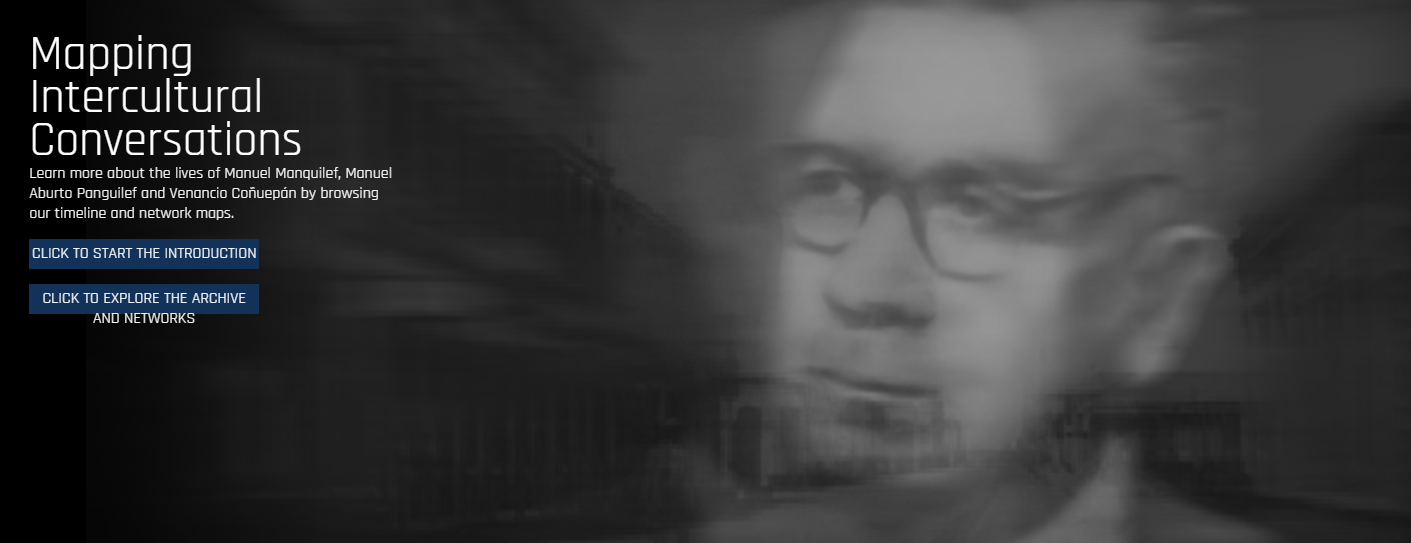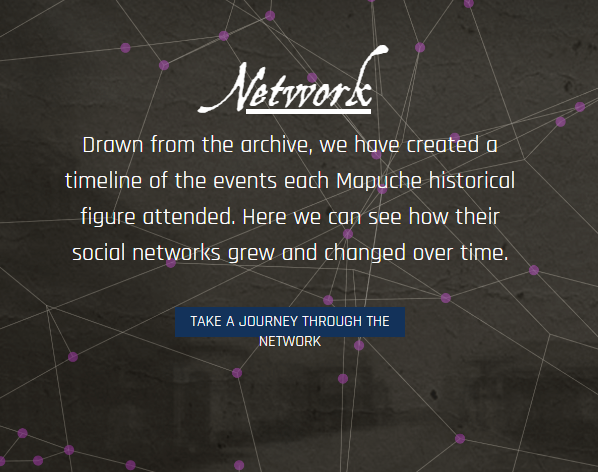Mapping Intercultural Connections and Conversations of the Past
What methods can be used to reveal under-explored stories and create interactive digital maps of the social networks of Chile’s most prominent indigenous political activists in the early 20th century?

Leaders of the past, like those of the present, never act alone. An individual’s networks and what they do with them can help to explain how a person eventually comes to represent others in the public sphere. Mapping Intercultural Connections and Conversations traced the vast web of contacts that Manquilef, Aburto Panguilef and Coñuepán developed in order to deepen our understanding of how and why they became the important intellectual and political mediators that they did, and to stimulate a discussion about their continuing relevance today. This is vital in a context where the dominant narrative (propagated by both the state and many indigenous activists) is one of violent conflict between innately opposed “cultures”. This project did not negate either the existence or the tragic consequences of conflict in contemporary Chile, but it sought to reveal alternative realities.
What did the project involve?
This collaborative project aimed to make visible the complex social networks of three of the most prominent Mapuche intellectual activists in early-twentieth-century Chile: Manuel Manquilef (1887-1950), Manuel Aburto Panguilef (1887-1952) and Venancio Coñuepán (1905-1968). Through interactive digital maps it also sought to encourage people, particularly secondary school students and teachers in Chile, to dig further into these networks.
Mapping Intercultural Connections and Conversations sought to build on the success of a previous British Academy/ Newton-funded project (2015-2016), which was co-led by Jo Crow and Allison Ramay.
The outcome of that project was a dataset of approximately 1200 connections for Manquilef, Aburto Panguilef and Coñuepán (approximately 400 for each), and the expansion of academic networks through three workshops. These brought together scholars in different disciplines from Chile, the U.S., the U.K. and Sweden to talk about the multiple, sometimes conflicting stories to come out of that dataset.
Working together with three new partners, this project aimed to take the previously amassed material (about these figures’ networks) and knowledge (of digital visualisation tools) in a new direction.
With the help of creative technologist Ewan Cass-Kavanagh, the project sought to explore innovative and exciting ways of representing the data that had been collected. The researchers wanted to make it easily accessible through an online platform and to bring to life the key ideas that they saw emerging from the data (principally for educators and students in Chile, but also for a general-interest English-speaking audience).
Critically, they wanted to build a bridge between the data that they had compiled and the local Mapuche community in Chile whose histories it exposed. To this end, they worked in dialogue with two Mapuche teachers from Villarrica and Santiago.
The team sought to experiment with new interfaces for real-world digital history telling – i.e. visually engaging histories that are accessible to all, not just those in metropolitan centres with high-speed, low cost Internet access. They attempted to apply creative story telling methods to their dataset in order to bring some of the ideas (that spring forth from it) to life.
The initial idea was for a webpage (in Spanish and English) that:
- Enables access to an assortment of key primary sources (e.g. newspaper articles, diary entries, letters).
- Enables access to the dataset of connections, and encourages readers to contribute new information.
- Acts as an entry point to multiple digital visualisations of this dataset: for example, pre-created geographic maps or network diagrams. Ideally, users would also be able to filter and reorganise the data and create their own visualisations from it.
- Combines these data visualisations with crafted storytelling.
Who are the team and what do they bring?
- Joanna Crow (Hispanic, Portuguese and Latin American Studies, University of Bristol) is a historian who’s research interests include Chilean cultural history, nationalism and nation building, and Mapuche history, intellectuality and politics. Her new research project investigates the production of knowledge and circulation of ideas about race and indigenous cultures in twentieth century Latin America, focusing specifically on Chilean-Peruvian intellectual networks.
- Allison Ramay (Faculty of Language and Literature, and the Interdisciplinary Centre for Intercultural and Indigenous Studies, Pontifical Catholic University of Chile) is a researcher who’s studies focus on the representation and self-representation of the Mapuche from the 19th century to the present. She was co-editor of an anthology of Mapuche women’s poetry (Hilando en la memoria, Cuarto Propio, 2006), translated into English the poems of Graciela Huinao (Walinto, Cuarto Propio, 2009) and has published articles on Mapuche poetry and the works by Manuel Manquilef.
- Mariela Carimán Puñalef (Centre for Intercultural and Indigenous Studies, Pontifical Catholic University of Chile) is a Social Science teacher, and expert in the themes of cultural heritage and intercultural education. She is Mapuche and is in charge of communicating with the Mapuche communities that the Centre of Intercultural and Indigenous Studies works with in the region of Araucanía and in evaluating their intercultural education curricula.
- Maribel Mora Curriao (Department for Equality and Inclusion, University of Chile) is a widely-published and critically acclaimed Mapuche poet. She has experience of teaching in secondary schools and in the higher education sector, and is currently Director for the Department of Equality and Inclusion at the University of Chile
- Ewan Cass-Kavanagh (Chaka Studio Collective) is a creative technologist working across the fields of interactive documentary and digital social innovation. He has provided consultancy for third sector and arts organisations, as well as working with marginalised groups such as UK’s homeless and Peru’s indigenous communities to capitalise on the benefits of the Internet despite being offline.
What were the results?
The project developed the website Mapping Intercultural Conversations which utilised timelines and network maps to teach about the lives of Manuel Manquilef, Manuel Aburto Panguilef and Venancio Coñuepán.





